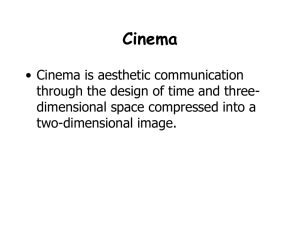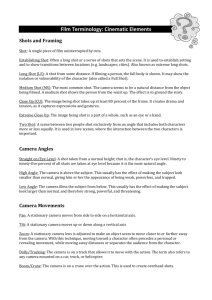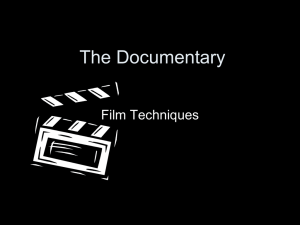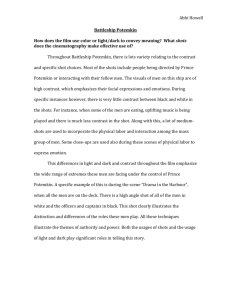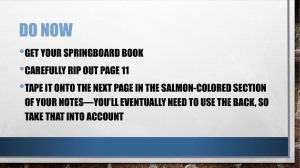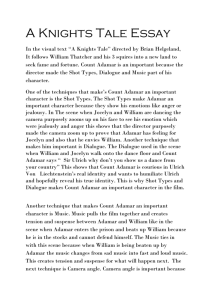Film Analysis Terminology
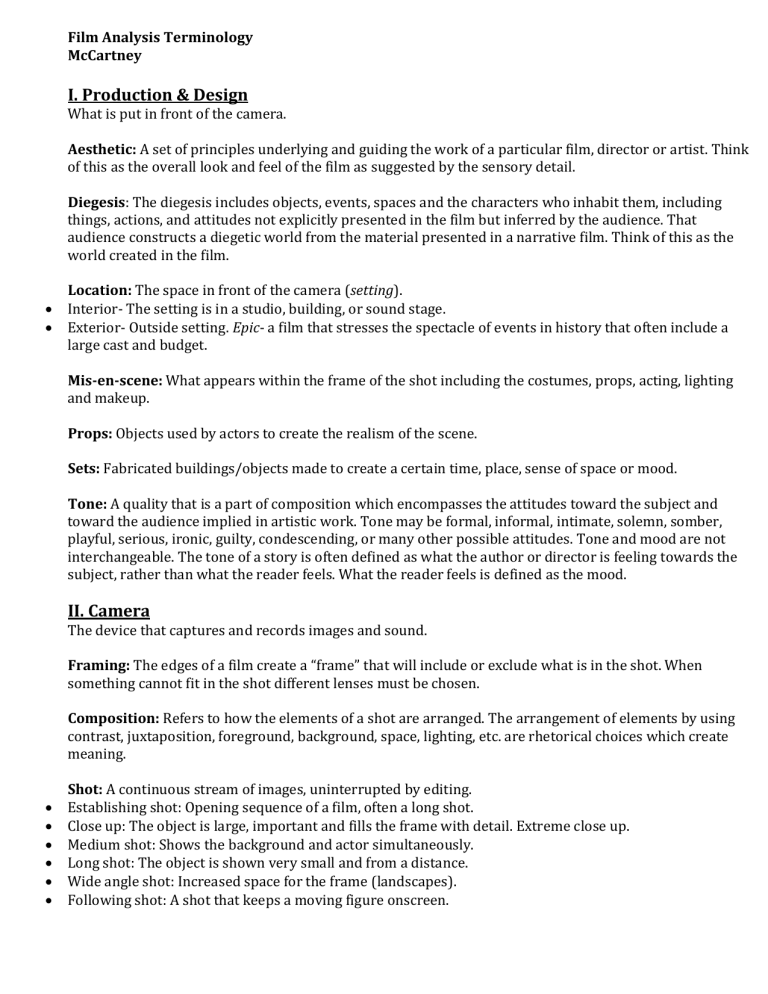
Film Analysis Terminology
McCartney
I. Production & Design
What is put in front of the camera.
Aesthetic: A set of principles underlying and guiding the work of a particular film, director or artist. Think of this as the overall look and feel of the film as suggested by the sensory detail.
Diegesis: The diegesis includes objects, events, spaces and the characters who inhabit them, including things, actions, and attitudes not explicitly presented in the film but inferred by the audience. That audience constructs a diegetic world from the material presented in a narrative film. Think of this as the world created in the film.
Location: The space in front of the camera (setting).
Interior- The setting is in a studio, building, or sound stage.
Exterior- Outside setting. Epic- a film that stresses the spectacle of events in history that often include a large cast and budget.
Mis-en-scene: What appears within the frame of the shot including the costumes, props, acting, lighting and makeup.
Props: Objects used by actors to create the realism of the scene.
Sets: Fabricated buildings/objects made to create a certain time, place, sense of space or mood.
Tone: A quality that is a part of composition which encompasses the attitudes toward the subject and toward the audience implied in artistic work. Tone may be formal, informal, intimate, solemn, somber, playful, serious, ironic, guilty, condescending, or many other possible attitudes. Tone and mood are not interchangeable. The tone of a story is often defined as what the author or director is feeling towards the subject, rather than what the reader feels. What the reader feels is defined as the mood.
II. Camera
The device that captures and records images and sound.
Framing: The edges of a film create a “frame” that will include or exclude what is in the shot. When something cannot fit in the shot different lenses must be chosen.
Composition: Refers to how the elements of a shot are arranged. The arrangement of elements by using contrast, juxtaposition, foreground, background, space, lighting, etc. are rhetorical choices which create meaning.
Shot: A continuous stream of images, uninterrupted by editing.
Establishing shot: Opening sequence of a film, often a long shot.
Close up: The object is large, important and fills the frame with detail. Extreme close up.
Medium shot: Shows the background and actor simultaneously.
Long shot: The object is shown very small and from a distance.
Wide angle shot: Increased space for the frame (landscapes).
Following shot: A shot that keeps a moving figure onscreen.
Focus: The depth in field of a shot
Soft focus: a director intentionally puts their object slightly out of focus to make the image look softer or unclear.
Rack focus: a director shifts the focus from one object to another in the same shot in order to direct the audience’s attention.
Deep focus: foreground and background are equally in focus.
Camera Angle: The physical relationship between the camera and actors
High angle: The camera is looking down at subject. Creates vulnerability.
Eye level: Also called Point of View: Camera placed at eye level. Often these are the most natural and even with the face.
Low angle: The camera is looking up at a subject. Creates size, power, and status.
Dutch angle: A shot that is tilted sideways on the horizontal line; used to create tension, or create a distorted or sinister view.
Camera Movement: Any motion of the camera during a shot.
Hand held: Shot with camera and cameraman. Often wobbly.
Zoom: A movement of a camera up close but from a distance
Pan: A movement of the camera from side to side.
Tilt: Movement of the camera up and down.
Telephoto: An image shot with an extremely long lens.
Crane shot: The camera is placed on a crane and moves through the air in any direction.
Tracking: a single continuous shot made with the camera moving on the ground and following a moving object or person.
Dolly: A wheeled platform built to carry a camera and to follow movement during filming.
Lighting: The intensity, direction and quality of light.
Low-key: The scene is flooded with shadows and darkness.
High-key: The scene is flooded with light.
Natural/Neutral light: The natural light cast by the sun.
Black and White: The use of shadow and monochrome film.
Color- Color film is vivid, fuzzy or dull.
Front/backlighting-Light which comes behind objects or actors.
Bottom/side-direct lighting from below or from side.
Sound: The content and intensity of what is heard.
Sound effects: Added sounds that are neither dialogue nor music.
Dialogue: Words spoken by the actors.
Music: Musical soundtrack, instrumental, orchestral or score.
Silence: A lack of natural sound to heighten the moment.
Voice over: A voice is speaking outside the action of the actor on screen: Also called Narration.
Off screen sound: Sound that is happening off screen.
III. Editing
The intentional joining together of film clips into a filmstrip to convey meaning.
Clip: Each segment of video between cuts.
Cut: The splicing of one shot into another.
Scene & Sequence
A scene is a segment of a narrative film that usually takes place in a single time and place, often with the same characters. Sometimes a single scene may contain two lines of action, occurring in different spaces or even different times, that are related by means of crosscutting. Scene and sequence can usually be used interchangeably, though the latter term can also refer to a longer segment of film that does not obey the spatial and temporal unities of a single scene.
Crosscutting: Editing that alternates shots of two or more lines of action occurring in different places, usually simultaneously. The two actions are therefore linked, associating the characters from both lines of action.
Cut-in, Cut-away: An instantaneous shift from a distant framing to a closer view of some portion of the same space, and vice versa.
Dissolve: A transition between two shots during which the first image gradually disappears while the second image gradually appears; for a moment the two images blend in superimposition.
Iris: A round, moving mask that can close down to end a scene (iris-out) or emphasize a detail, or it can open to begin a scene (iris-in) or to reveal more space around a detail.
Establishing Shot: A shot, usually involving a distant framing, that shows the spatial relations among the important figures, objects, and setting in a scene. Usually, the first few shots in a scene are establishing shots, as they introduces us to a location and the space relationships inside it.
Shot/Reverse Shot: Two or more shots edited together that alternate characters, typically in a conversation situation. In continuity editing, characters in one framing usually look left, in the other framing, right. Over-the-shoulder framings are common in shot/reverse-shot editing.
Wipe: A transition betwen shots in which a line passes across the screen, eliminating the first shot as it goes and replacing it with the next one. A very dynamic and noticeable transition, it is usually employed in action or adventure films. It often suggest a brief temporal ellypsis and a direct connection between the two images.
Matches: Editing matches refer to those techniques that join as well as divide two shots by making some form of connection between them. That connection can be inferred from the situation portrayed in the scene (for example, eyeline match) or can be of a purely optical nature (graphic match)
Eyeline Match: A cut obeying the axis of action principle, in which the first shot shows a person off in one direction and the second shows a nearby space containing what he or she sees. If the person looks left, the following shot should imply that the looker is offscreen right.
Graphic Match: Two successive shots joined so as to create a strong similarity of compositional elements
(e.g., color, shape).
Flashback/Flashforward: A jump backwards or forwards in diegetic time. With the use of flashback / flashforward the order of events in the plot no longer matches the order of events in the story.
Realtime: A scene presented in the actual time in which the event occurs.
IV. Story & Narrative
Story refers to all that the audience infers about the events that occur in the diegesis on the basis of what they are shown by the plot -- the events that are directly presented in the film. The order, duration, and setting of those events, as well as the relation between them, all constitute elements of the plot. Story is always more extensive than plot even in the most straightforward drama but certain genres, such as the film noir and the thriller, manipulate the relationship of story and plot for dramatic purposes.
Symbolism: The use of symbols to represent ideas or qualities.
Motif: A recurring object or sound that becomes linked to a film in a meaningful way.
Mood: The emotions experienced by the viewer. Mood may change scene to scene, but may also develop over the course of an entire film.
V. Genre
Types of film recognized by audiences and/or producers, sometimes retrospectively. These types are distinguished by narrative or stylistic conventions, setting, or merely by their discursive organization in influential criticism.
Action
Adventure
Comedy
Crime
Drama
Documentary
Epic/Historical
Fantasy
Film-Noir
Horror
Martial Arts
Musical/Dance
Mystery
Religious
Romance
Science Fiction
Short
Silent
Sports
War
Western
Others? List here:

